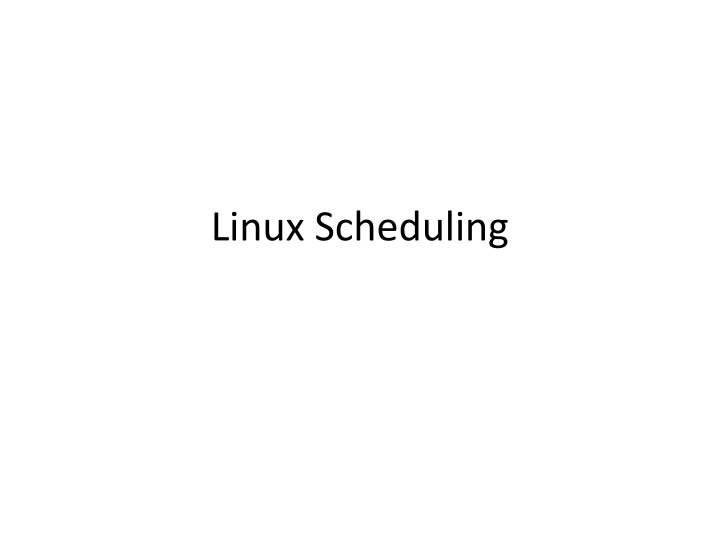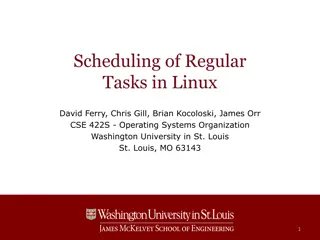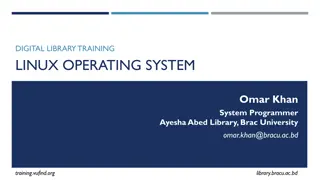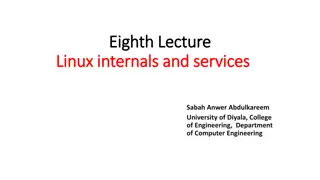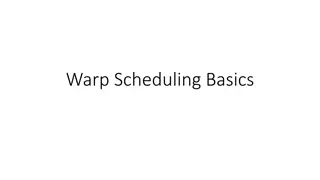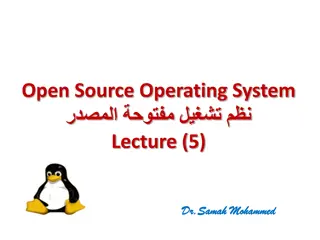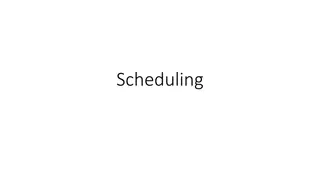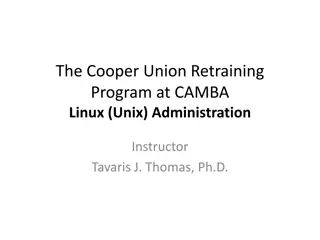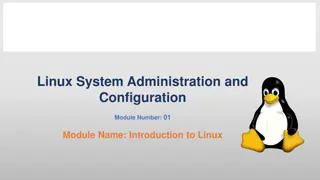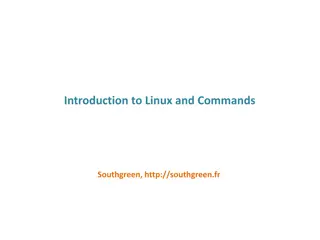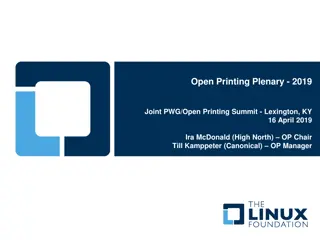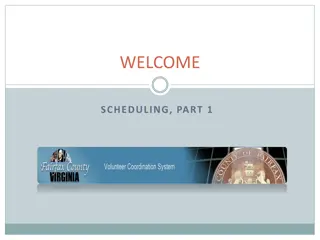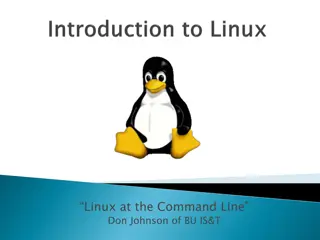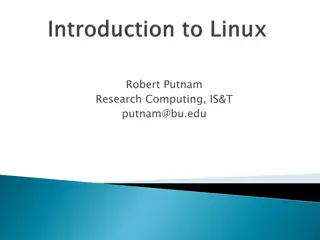Linux Scheduling
This content delves into different aspects of Linux scheduling, from the real-world scenarios to the evolution of schedulers in Linux versions. It covers topics such as process selection, priorities, task handling, the Linux 2.4 scheduler, the Linux O(1) scheduler in version 2.6, run queues, approach to task selection, handling blocking scenarios, and wait queues in the context of scheduling processes efficiently.
Download Presentation

Please find below an Image/Link to download the presentation.
The content on the website is provided AS IS for your information and personal use only. It may not be sold, licensed, or shared on other websites without obtaining consent from the author.If you encounter any issues during the download, it is possible that the publisher has removed the file from their server.
You are allowed to download the files provided on this website for personal or commercial use, subject to the condition that they are used lawfully. All files are the property of their respective owners.
The content on the website is provided AS IS for your information and personal use only. It may not be sold, licensed, or shared on other websites without obtaining consent from the author.
E N D
Presentation Transcript
Real World Scheduling Select process to run next Must handle Priorities Forking where does child go? What about if you only use part of your quantum? E.g., blocking I/O
Linux 2.4 Linux scheduler had a single list of tasks Scanned entire list looking for best task to run Applied a goodness function to each task Generated a priority metric to compare tasks with O(n) Linear complexity (n = number of tasks) Time broken into epochs Each process had a window of time in epoch If time wasn t used: half of left over time saved for next epoch
Linux O(1) Scheduler (2.6) runqueue: a list of runnable processes Blocked processes are not on any runqueue A runqueue belongs to a specific CPU Each task is on exactly one runqueue Task only scheduled on runqueue s CPU unless migrated 2 *40 * #CPUs = # of runqueues 40 dynamic priority levels (more on this later) 2 sets of runqueues one active and one expired
Approach Take first task from lowest runqueue on active set Lower priority value means higher priority When done, put it on runqueue on expired set On empty active, swap active and expired runqueues Constant time Fixed number of queues to check Only take first item from non-empty queue
Blocking What if a program blocks on I/O? Still has part of its quantum left Has nothing to execute Removed from active and expired runqueues Need a wait queue for each blocking event Disk, lock, pipe, network socket, etc
Wait Queues Blocked tasks are stored on wait queues Moved back when event happens No longer on any active or expired queue! Disk example: I/O completes IRQ handler moves task from wait queue to active runqueue
Time Slices A process blocks and then becomes runnable How much time did it have left? Each task tracks time left in time_slice field On each clock period: current->time_slice-- If time slice goes to zero, move to expired queue Refill time slice Schedule someone else An unblocked task can use balance of time slice Forking halves time slice with child
Priorities Based on nice levels nice value: user-specified adjustment to base priority 100 = highest priority 139 = lowest priority 120 = base priority Selfish (not nice) = -20 (I want to go first) Really nice = +19 (I will go last)
Time Slice assignment Priority < 120 Time slice = (140 priority) * 20ms Priority >= 120 Time slice = (140 priority) * 5ms Higher priority tasks get longer time slices And run first
Interactive Tasks Most GUI programs are I/O bound on the user Unlikely to use entire time slice Users care about interactivity Latency or responsiveness to user events Typically Keyboard/Mouse events Scheduler tries to give UI programs a priority boost Move to front of line, run briefly, block on I/O again Scheduler must somehow identify interactive tasks
Heuristic based classification I/O bound applications wait on I/O Don t need much CPU time Scheduler monitors I/O wait time Infer which programs are GUI (and disk intensive) Processes that do a lot of I/O get a priority boost Note that this behavior can be dynamic GUI does something compute intensive E.g. image rendering Scheduling should match program phases
Dynamic Priorities Real Priority = static priority bonus + 5; floor(100) && ceil(139) Bonus is calculated based on sleep time Dynamic priority determines a tasks runqueue Balance throughput and latency with infrequent I/O May not be optimal Heuristically driven Seems to work, but is pretty ugly Edge cases can cause it to break
Dynamic Priorities Runqueue determined by the dynamic priority Not the static priority Dynamic priority mostly based on time spent waiting To boost UI responsiveness and fairness to I/O intensive apps nice values influence static priority Can t boost dynamic priority without being in wait queue! No matter how nice you are (or aren t)
Setting static priorities int setpriority(int which, int who, int prio); int getpriority(int which, int who); which: process, process group, or user id who: PID, PGID, or UID prio: nice value (-20 to +19) int nice(int inc); Historical interface (backwards compatible) Equivalent to: setpriority(PRIO_PROCESS, getpid(), niceval)
CFS Scheduler (later 2.6) O(1) scheduler is complicated Heuristics for various issues makes it more complicated Heuristics can end up working at cross-purposes Desire for something simpler and elegant Based on a simple list of tasks (conceptually) Ordered by how much time they ve used Always pick the neediest task to run Until it is no longer neediest Then re-insert old task in the timeline Schedule the new neediest Implements a form of Weighted Fair Queueing
Fairness 50 tasks, each should get 2% of CPU time Do we really want this? What about priorities? Interactive vs. batch jobs? Per-user fairness? Alice has 1 task and Bob has 49; Why should Bob get 98% of CPU?
CFS details Global virtual clock: ticks at a fraction of real time Fraction is number of total tasks Each task accumulates time in proportion to total # of tasks Stores accumulated time as a variable Accumulated time subtracted as task runs Example: 4 tasks Global vclock ticks once every 4 real ticks Each task allocated one real tick Tasks stored in a red-black tree sorted based on their allocation of ticks struct rbtree; Generic kernel data structure Task with largest allocation of ticks is scheduled next CPU time is allotted based on the tick allocations Messing with the tick allocations allows flexibility
Priorities Priorities allow scheduler to be unfair In CFS, priorities determine the ticks allocated to a task Example: For a high-priority task 10 real clock ticks may be allocated per global virtual tick For a low-priority task A virtual, task-local tick may only last for 1 actual clock tick Higher-priority tasks run longer Low-priority tasks make some progress
Weighted Fair Queueing GUI programs are I/O bound We want them to be responsive to user input Need to be scheduled as soon as input is available Will only run for a short time CFS blocked tasks removed from RB-tree Just like O(1) scheduler Virtual clock keeps ticking while tasks are blocked Increasingly large deficit between task and global vclock When a GUI task is runnable, goes to the front Dramatically lower vclock value than CPU-bound jobs
Grouping Per group or user scheduling Controlled by real to virtual tick ratio Function of number of global and user s/group s tasks Can group processes in multiple ways Can support group hierarchies Scheduler doesn t operate on tasks, threads or processes Uses a generic sched_entity structure Sched entity can refer to anything that can run Can also refer to a set of sched_entities Allows recursiveness in the scheduler Easily extendable to support cgroups Basis for containerization
